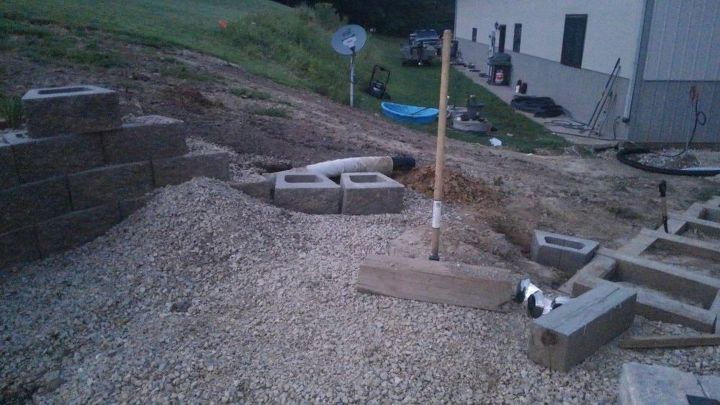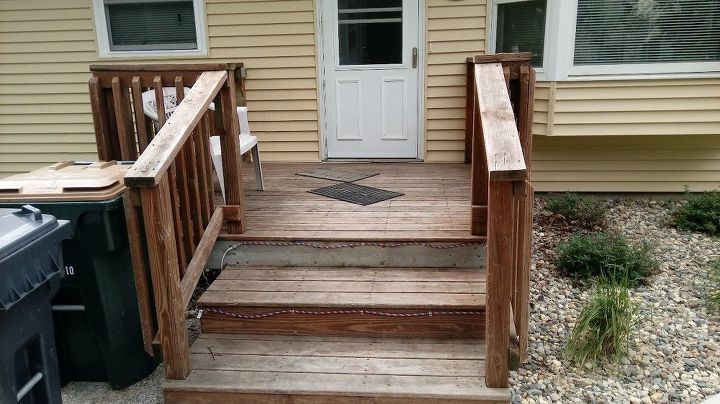How do I build a retaining wall?

My front yard has a "slope" and the soil is starting to errode and it washes onto the sidewalk. Easy DIY for a woman to do by herself?
Related Discussions
Build a short retaining “wall”around a pool ?
Need to build up a short wall around above ground pool to shore up the fill around the pool. I plan on stacking and securing 3-4 landscape timbers . I would like to p... See more
How do I finish a retaining wall when both sides are exposed?
How do I finish a retaining wall when both sides are exposed at the end.
I have a brick retaining wall that is growing moss. Any suggestions for removing it? Cleansers, brushes, etc. Thanks.
How can I build a privacy fence on top of a 6 foot block wall?
How do I build a basketball court with textured mat?
How do I prepare my grass before I place the mats?
How do I build a covered entry over a 6x6 deck style front step?
Our front door opens on to a wooden deck about 6x6, with two steps down to the front walk. The eaves drip on us and winter winds chill the house. A covered entry woul... See more





Hi, Robin,
This project depends upon degree of slope , height of wall, how much rain your receive, soil conditions, freeze/thzw issues in your area. Paver blocks can weigh 80 plus pounds, each, for better blocks. Timbers, sandstone can fail due to ground slope, hydrostatic pressure, etc.
At the least, consult with a specialist who does retaining walls and who provides a written warranty.
You may need many tons of gravel and professional landscape fabric, as well as a water drainage system behind your wall. Many municipalities require a permit for walls, dependent upon their height.
It's probably only 2 1/2 feet tall. My thought was to dig out the lawn to the sidewalk and once the retaining wall is in place dirt and grass seed to make the ground level.
You could put in some tiers that would keep the soil in for you. It depends on how severe a slope you have in your front yard. We live in a neighborhood that is on a huge hill, one steep hill in the front and two steep hills in the back. We have a small garden around our yard light and the people who lived there before use just left it going down hill and constantly lost soil to the bottom of the garden. Last spring we leveled it out and it took three layers of 4x4's on the front to one at the back to get it as level as we could get it. If it is steep, you could put in a few tiers, or one high retaining wall at the sidewalk.
OMG did you seriously say " for a woman to do by herself?" You can do anything! even move heavy objects just not the same way a man does/can. I am 5'6" 120lbs & did professional landscaping over 20yrs and I don't mean just mowing lawns,planting flowers although I did that part too. Don't limit yourself because of what others(or even yourself) perceive/think you should be able to do. OK OFF of my soap box Here's basics https://www.youtube.com/watch?v=s-WkBDgcap4 MORE https://www.youtube.com/watch?v=nsC0OsI8rhE Another https://www.youtube.com/watch?v=57HG5r5bqWs wear soft leather gloves and take your time,use good sharp pointed shovel to dig(stick point in then stand on it rocking back & forth to get down in ground)wet ground easier to dig but heavier to move,hold tools/ wheelbarrow choking up on handles, a women's center of gravity&strength is lower than men's so tools are easier to use if you hold them closer to main part, hold shovel closer to head ,step between wheelbarrow handles more towards it and dump sideways not tipping up overg head. You can do this & when your done you'll be so proud of yourself. I don't know where you live but if you keep wall low you probably won't need any permits unless you have some ridiculous HOA etc. You'll be sore it'll be a good sore take some aspirin and good hot bath Lowes/Home depot should/will deliver the blocks
What I meant was . . . Without anyone else's help. I do 90% of my own home projects inside and out by myself. Unless it requires extensive electrical or plumbing, then I hire someone. I just have never tackled something like this before. Not looking to rent heavy equipment or anything to build a retaining wall that is around 2" x 12".
Have you thought about planting rather than building?
Many years ago, I lived in a house that was around 10' higher than the road & we (it was my parents' house) had a similar problem. They got around it by packing the land with ground covering plants. These were plants which had good roots to help bind the soil and which came back year after year - the whole lot required hardly any maintenance. The plants came into flower at different times of the year so the slope always had a show of colour. Near the top of the slope my dad planted some shrubs/bushes, their deeper roots helped consolidate the soil at the top.
The slope was first 'tiered' or 'stepped' before being covered with plants. The idea behind that was to discourage rainwater from simply running away straight down the slope, it would mostly be absorbed before getting a chance to run away.